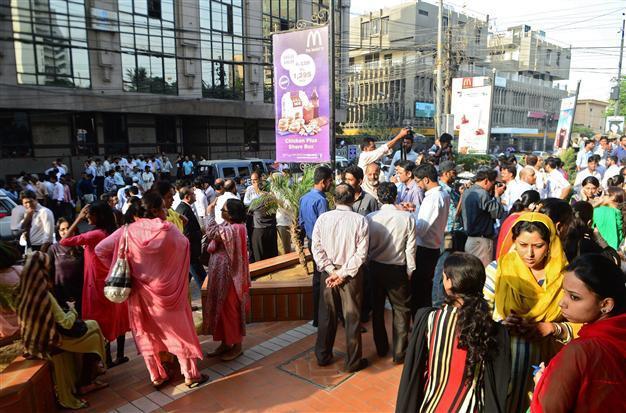At least 46 killed in major Pakistan earthquake
QUETTA, Pakistan - Agence France-Presse

Pakistani pedestrians and office workers leave an office building after an earthquake in Karachi on September 24, 2013. AP Photo
A huge earthquake hit southwest Pakistan on Sept. 24, killing at least 46 people, toppling scores of homes and sending people around the region rushing into the streets in panic.
The 7.7-magnitude quake - which sparked warnings of heavy casualties from seismologists - was centred in Baluchistan province's Awaran district but was felt as far afield as New Delhi and Dubai.
Officials said the quake, which struck at at 4:29 p.m. local time, demolished dozens of houses in Awaran, 350 kilometres southwest of the Baluchistan provincial capital Quetta. Its epicentre was 20 kilometres below ground.
The area is sparsely populated and most buildings are mud-built. But the U.S. Geological Survey issued a red alert, warning that heavy casualties were likely based on past data.
Asad Gilani, one of the most senior officials in the Baluchistan administration, told AFP that at least 46 people had been confirmed killed and 100 injured.
"A large number of houses have collapsed in the area and we fear the death toll may rise," said Rafiq Lassi, police chief for Awaran district.
Reports of heavy lossesThe provincial government declared an emergency in Awaran and the military mobilised medical teams as well as 200 soldiers and paramilitary troops to help with the immediate relief effort.
"We have received reports that many homes in Awaran district have collapsed. We fear many deaths," Jan Muhammad Baledi, a spokesman for the Baluchistan government, said on the ARY news channel.
"There are not many doctors in the area but we are trying to provide maximum facilities in the affected areas." Television footage showed collapsed houses, caved-in roofs and people sitting in the open air outside their homes, the rubble of mud and bricks scattered around them.
Abdul Qudoos Bizinjo, deputy speaker of Baluchistan's parliament, told Dunya TV there were reports of "heavy losses" in Awaran. Damage to the mobile phone network was hampering communications in the area, he said.
Awaran district has an estimated population of around 300,000, scattered over an area of more than 21,000 square kilometres.
A new island appeared after the quake close to the coastline of Gwadar, officials said.
"The island, which is up to 100 feet high and 200 feet wide, surfaced after the earthquake hit parts of Baluchistan," senior local administration official Tufail Baluch told AFP.
He said a similar island had appeared at the same place in the sea about 60 years ago but disappeared after some time.
Tremors felt in DubaiTremors were felt as far away as the Indian capital and even Dubai in the Gulf, while people in the Indian city of Ahmedabad near the border with Pakistan ran into the streets in panic.
Office workers in Pakistan's largest city Karachi rushed out of their buildings.
"Whenever I feel jolts it reminds me of the 2005 earthquake in Kashmir," said Amjad Ali, 45, an IT official standing in the street.
The 7.6 magnitude quake in 2005 centred in Kashmir killed at least 73,000 people and left several million homeless in one of the worst natural disasters to hit Pakistan.
In April a 7.8-magnitude quake in southeast Iran, close to the border with Baluchistan, killed 41 people and affected more than 12,000 on the Pakistan side of the border.
The Red Crescent in Tehran reported no damage from the latest quake.
Baluchistan, Pakistan's largest but least populous province, is believed to have substantial gas and oil reserves, but it is violent and unstable.
It is a flashpoint for growing violence against minority Shiite Muslims and has suffered attacks blamed on Taliban militants.
It also suffers from an ongoing separatist insurgency which began in 2004 when Baluch rebels rose up to demand a greater share of profits from the province's mineral resources.
